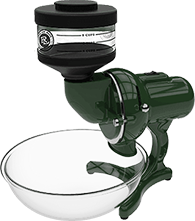The design and construction of the Lee Household Flour Mill reflect our principles of nutrition. By making a product with the intent of supporting people’s health, it wouldn’t make sense for the mill’s construction to lessen the nutritional value in any way. Dr. Lee, the inventor of the mill, knew that stone milling is the best way to handle grains during the milling process and so included a stone apparatus. Stone milling supports the nutritious quality of whole grains by keeping the temperature low and not eliminating any part of the grain.
Second only to diamonds in hardness, the stationary grinding stone never requires dressing and should last a lifetime. An air current is used to move the grain across the stationary stone, reducing it into fine flour. The process does not involve any metal plates or rollers. The transport and grinding of the grains is powered via a 1 HP motor equipped with a thermal protective switch to prevent overload and overheating. Once the grain is turned into flour, it is dispensed into a Pyrex bowl (included) and ready for use.
After using the mill, it can be easily disassembled and cleaned to eliminate flour residue. We include a brush with each of our mills for cleaning out the interior after each use. The stone and stainless steel interior parts can also be removed and cleaned with soap and water, ensuring that no flour stays within the mill and turns rancid. With the Lee Household Flour Mill, you can make the inside look as clean as the outside, no matter how many times you’ve used it. Because real, whole grain flour is a food product with an expiration date, we feel this is important.
As for the outside of the mill, we’ve carefully selected a smooth, non-absorbent aluminum alloy material. As fine as flour can be, it can blow around when the bowl cover gets removed after milling, or when you’re transporting flour from the bowl to other containers. After you’re finished milling, a simple wipe down of the aluminum alloy housing keeps your mill looking clean.
You may have seen other mills that use wood within their mill construction. These mills are considered by some to be more aesthetically pleasing and studier than their plastic counterparts. Consumer product safety standards for these (and all) household food processing appliances tend to concentrate more on electrical safety without establishing requirements for food contact surfaces.
The FDA food code for food-contact surfaces limits use of close-grain wood to cutting boards and paddles used at temperatures of 230°F or above. In the home, a study of cutting boards by the Department of Applied Biochemistry and Food Science, University of Nottingham1 suggested that wood presents a “greater potential hazard for cross contamination” than plastic.
The design and construction of our mill upholds FDA standards and allows us to offer our customers a quality product. Because our mill is a quality appliance, built to last for a lifetime, we chose material that would not wear down over time, need any kind of treatment to maintain it, or potentially create opportunity for flour rancidity within the mill. Ultimately, the material and design of the Lee Household Flour Mill upholds our focus on nutrition and health, and we know our customers appreciate this too.

